THIRD To EIGHTH WEEK OF DEVELOPMENT
Q. Which period of development is called Period of organogenesis?
A. It is embryonic period which extends from 3rd to eighth week of development. During this period the three germ layers give rise to specific tissues, structures and organs. By the end of this period, the main organ system have been formed and therefore it is called the period of organogenesis.
Q. What is gastrulation?
A. Gastrulation is the process by which the trilaminar embryo is formed. The epiblast layer having totipotential cells, gives rise to all 3 embryo layers: ectoderm, mesoderm and endoderm. It literally means the formation of gut (Greek, gastrula = belly). This occurs during third week of development.
Q. How are the three germ layers i.e. ectoderm, mesoderm and endoderm are formed?
A. All the three germ layers are derived m the epiblast. Initially there is formation of Primitive streak , then primitive groove on dorsal surface of epiblast. This is followed by invagination of epiblast cells. These invaginating cells first replace hypoblast to form endoderm, then they form mesoderm (a new third layer) in between ectoderm & endoderm. Epiblast cells that are remaining on the surface form ectoderm.
Q. Name the structures labeled 1- 6 in the following diagram.
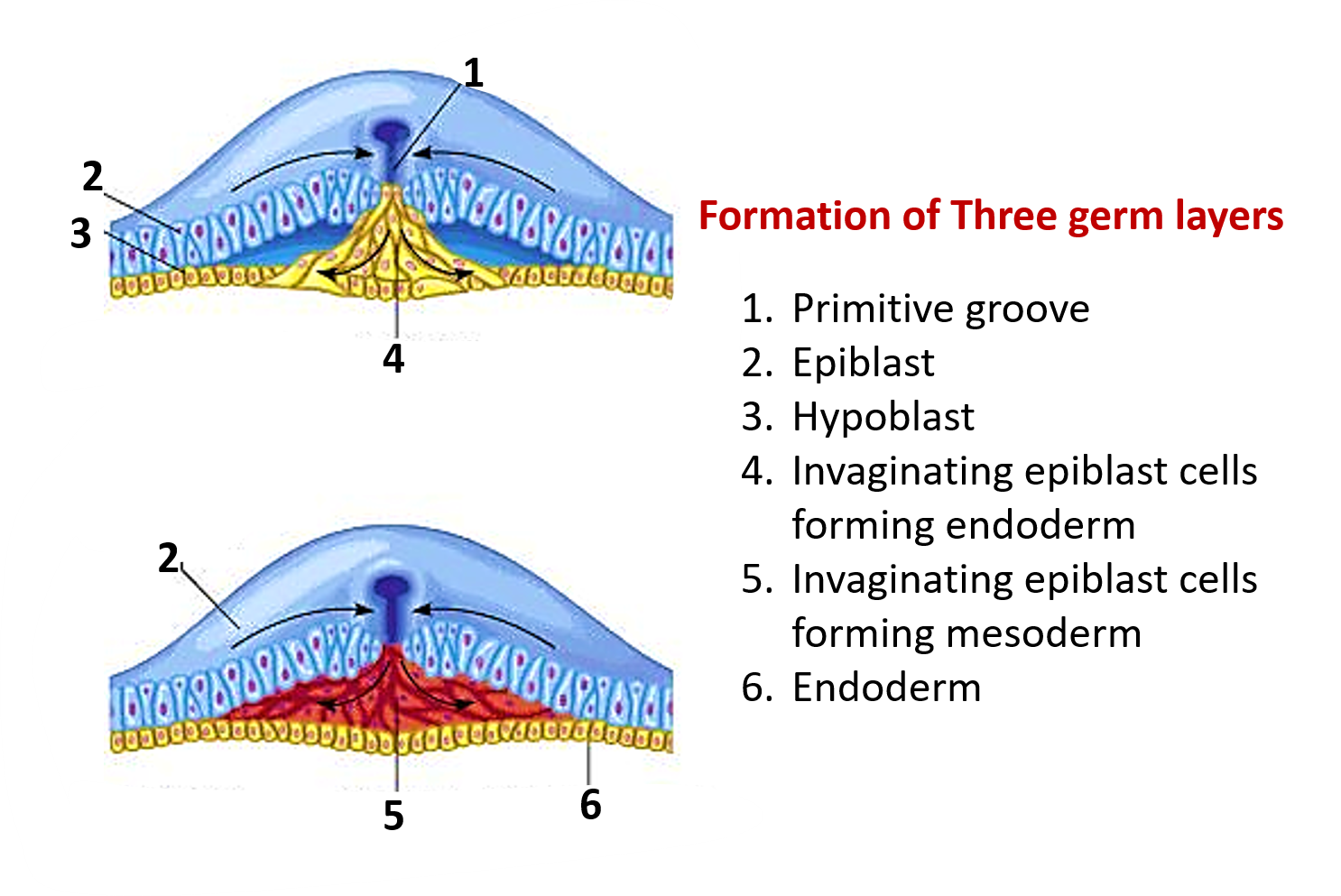
Q. Describe the process of formation of neural tube/neurulation.
A. Neurulation is the process of formation of neural tube which will give rise to future CNS. It begins on about about 18th day and is complete by 4th week of development. Following steps are involved in the formation of neural tube:
- Ectoderm is induced to form neuroectoderm by the underlying notochord and paraxial mesoderm.
- Neural plate is thus formed by thickened neuroectoderm which extends from prochordal plate to the primitive node.
- The lateral margins of neural plate are raised to form neural folds and the depressed midregion form neural groove.
- The neural folds come closer to each other and are fused to form neural tube. The fusion proceeds from cranial to caudal region.
Q. Name the structures labelled 1-13 in the following diagram.
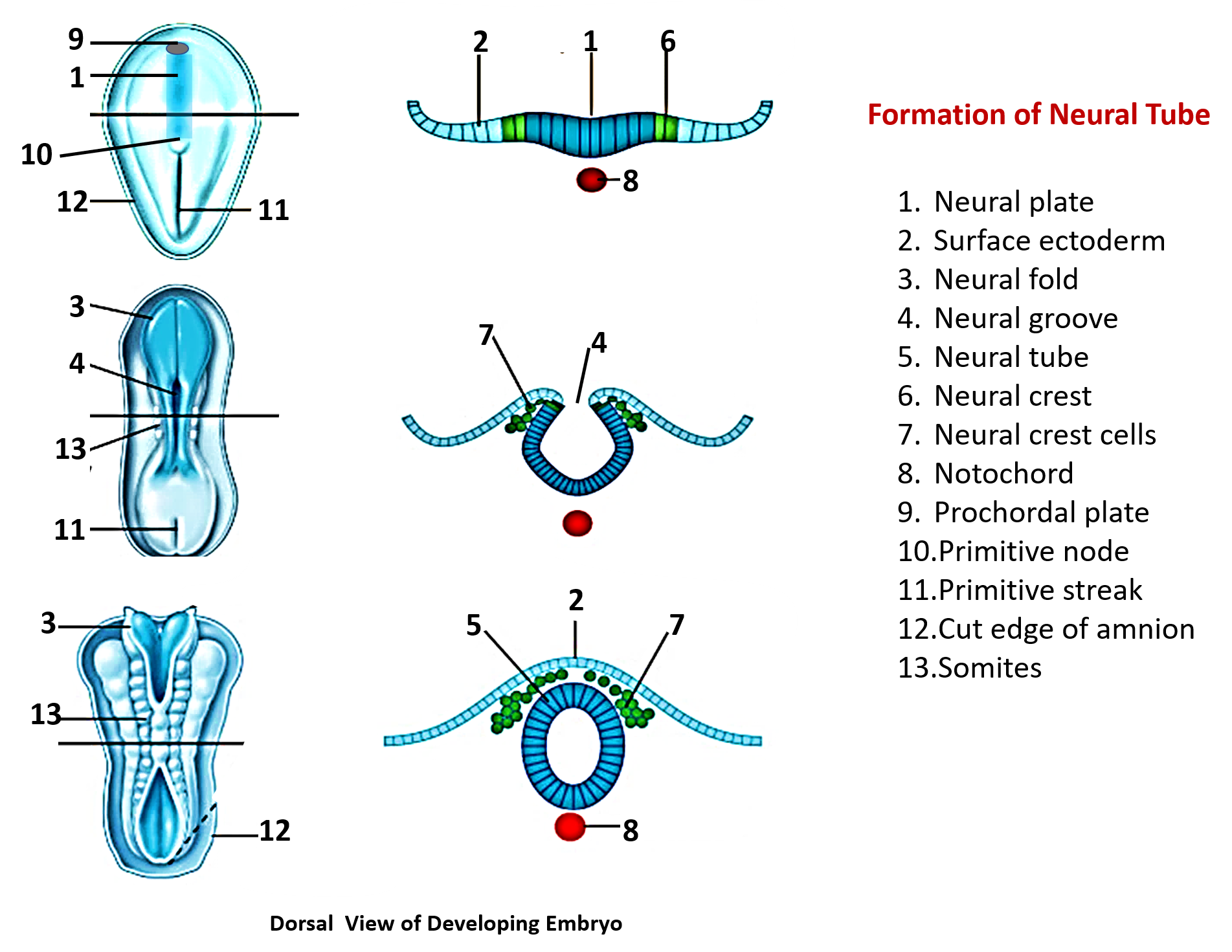
Q. What are anterior and posterior neuropores and when do they close?
A. The neural tube initially is open cranially and caudally where it is in communication with the amniotic cavity. The two openings are called anterior (cranial) neuropore and posterior (caudal) neuropore.
- Anterior neuropore closes by 25th day.
- Posterior neuropore closes by 27th day.
Q. Name the structures labeled 1-6 in the following diagram.
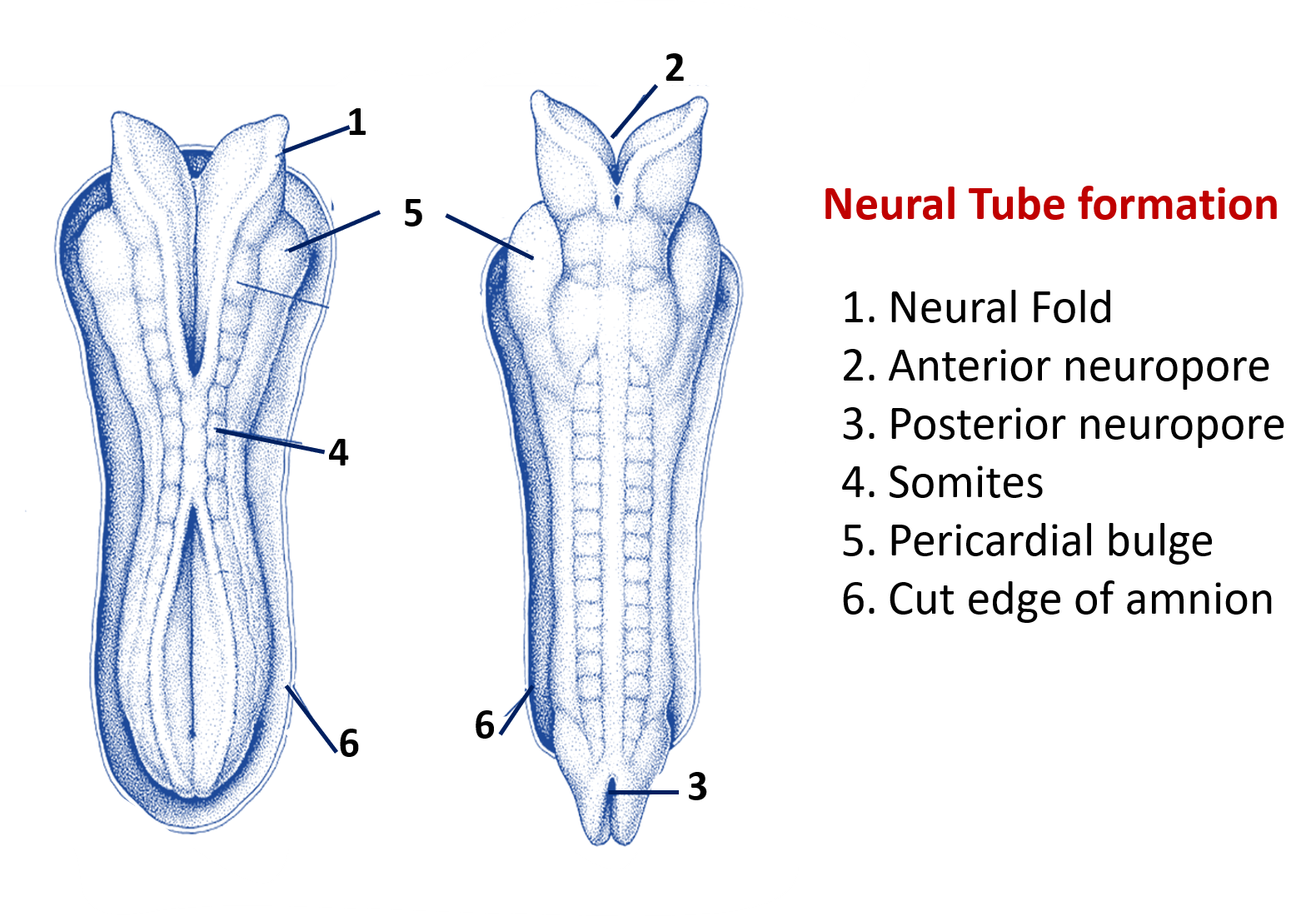
Q. What anomalies are caused dute to non-fusion of neural folds?
A. 1. Anencephaly : In case the neural folds do not fuse in the cranial region of the neural tube.
2. Craniorachischisis :When the fusion of neural folds fails along the entire length.
Q. How are neural crest cells formed and what are their adult derivatives?
A. When the neural folds fuse to form the neural tube, the cells at the crest of neuroectoderm begin to dissociate from neighbouring cells and migrate dorsolaterally between the surface ectoderm and the neural tube. Following are the derivatives of neural crest cells
- Spinal ganglia
- Ganglia of the autonomic nervous system
- Ganglia of cranial nerves V, VII, IX, X
- Schwann cells
- Meninges (arachnoid mater & pia mater)
- Pigment cells (melanocytes)
- Adrenal medulla
- Odontoblasts of tooth
- C cells of thyroid gland
- Connective tissue and bones of face and skull
- Bulbar and conal ridges of heart
Q. What are the derivatives of ectoderm?
A. Following are the derivatives of ectoderm:
| Skin and Appendages | Oral cavity | Gastrointestinal Tract | Urogenital system | Eye | Nose | Ear |
|---|---|---|---|---|---|---|
| Epidermis | Epithelial lining of anterior 2/3rd of tongue | Epithelial lining of lower part of anal canal | Epithelial lining of distal part of penil urethra | Conjunctiva | Epithelial lining of nasal cavity | Epithelial lining of external auditory meatus |
| Hair and nails | Ameloblast | Corneal epithelium | Paranasal air sinuses | Outer lining of tympanic membrane | ||
| Sweat and sebaceous glands | Parotid gland and ducts | Lens | Semicircular ducts and utircle | |||
| Arrectorum Pilorum muscle | Muscles of iris (sphincter and dilator pupillae) | |||||
| Mammary gland | Lacrimal gland and nasolacrimal duct | |||||
Q. What are the subdivisions of intraembryonic mesoderm?
A. the intraembryonic mesoderm is divided into three parts:
- Paraxial mesoderm
- Intermediate mesoderm
- Lateral plate mesoderm which is divided into two layers – Somatic/parietal and splanchnic/visceral
Q. Name the structures labeled 1-11 in the following diagram.
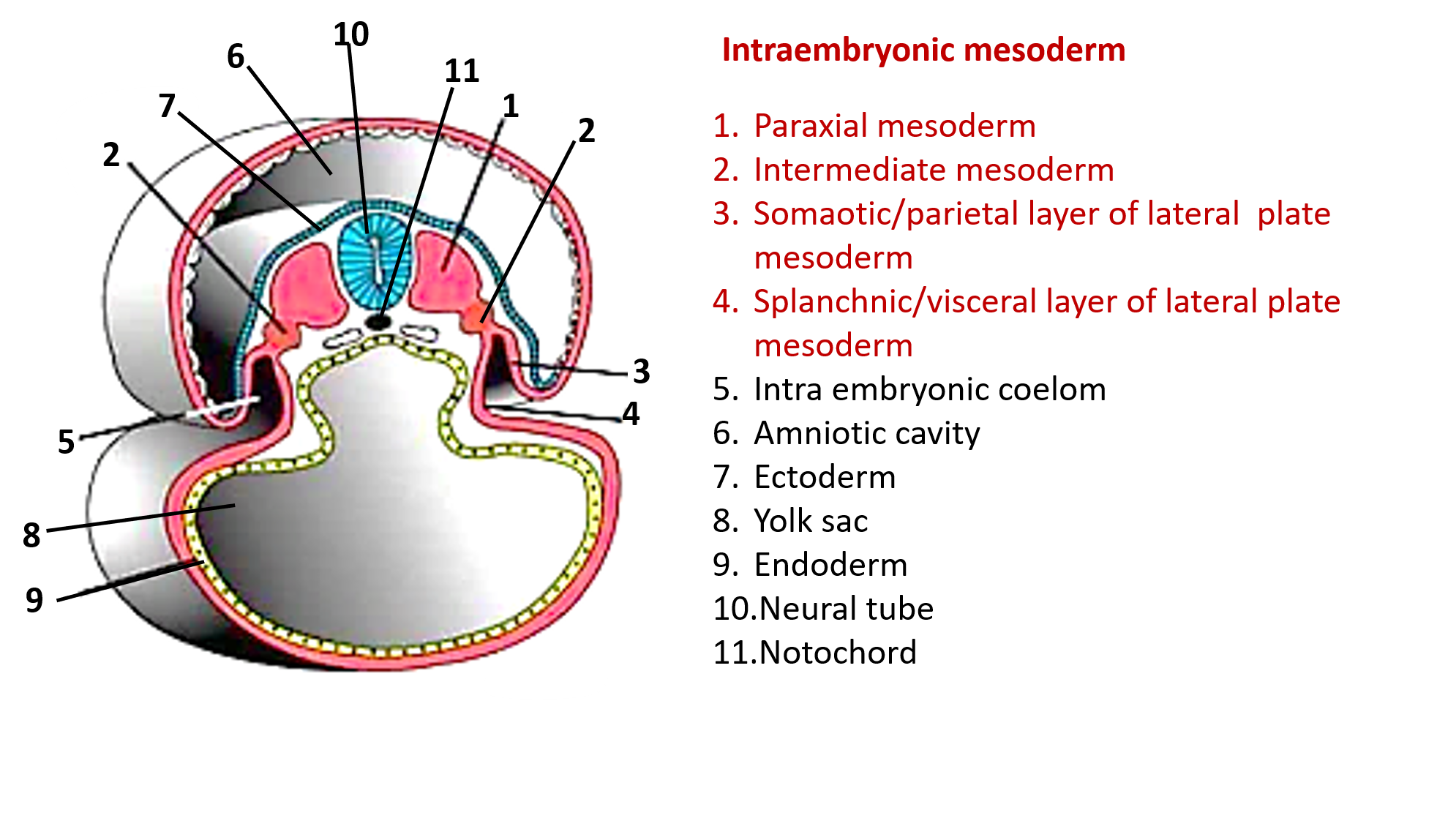
Q. What are somites? How many somites are present?
A. Somites are paired blocks of paraxial mesoderm that are formed bilaterally on both sides of neural plate along the head-to-tail axis of the developing embryo.
- 1st pair of somites appear in occipital regionby 20th day of development.
- Approximately 3 pairs of somites are added each day till 42-44 pairs are formed.
- In total there are following pairs of somites:
- 4 occipital
- 8 cervical
- 12 thoracic
- 5 lumbar
- 5 sacral
- 8-10 coccygeal
- 1st and last seven coccygeal somites disappear.
- The cells of the somites located medioventrally form the sclerotome which contribute to the formation of the axial skeleton.The dorsolaterally located cells of the somite form dermatomyotome This group of cells are further divide into two parts: myotome, which lie more medially and form the skeletal musculature and the dorsolateral dermatome which form dermis of skin.
Q. Name the structures labelled 1- 7 in the following diagram.
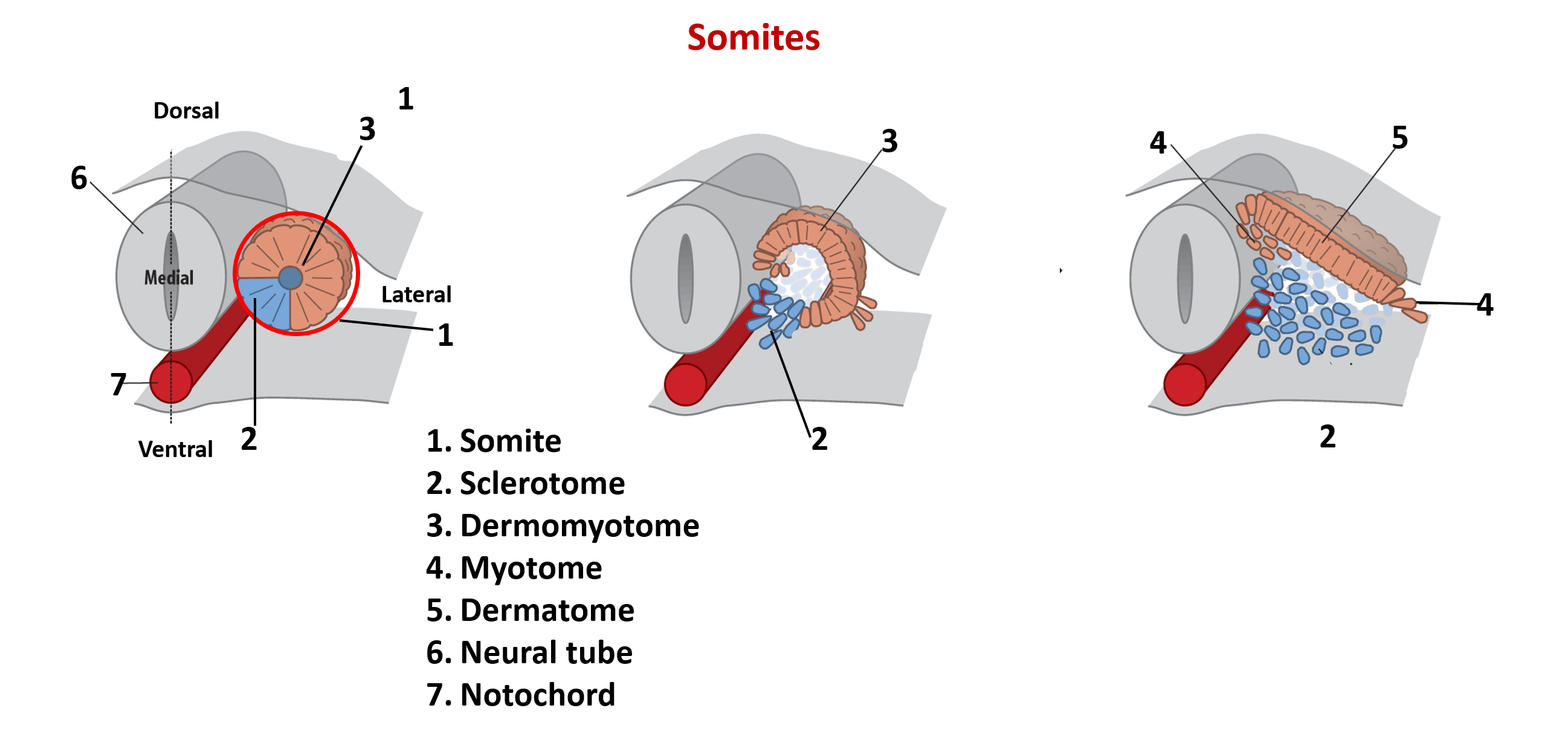
Q. What are the derivatives of mesoderm?
A. Following are the derivatives of mesoderm:
| Paraxial Mesoderm | Intermediate mesoderm | Lateral plate mesoderm |
|---|---|---|
| Dermis of skin | Urogenital system: Kidney, ureter, trigone of urinary bladder, Part of prostatic urethra, genital ducts, gonads ( testes and ovaries) | Cardiovascular and lymphatic system |
| Bones: Vertebrae , ribs and cranial | Blood cells, microglia, Kupffer cells | |
| Muscles: Skeletal muscles of limbs, trunk, head, neck, tongue and extraocular muscles | Limb bones | |
| Dura mater | Serous membranes of body cavities: pleura, pericardium and peritoneum | |
| Supra renal cortex | ||
| All the layers of walls of gastrointestinal tract except the epithelium | ||
| Spleen |
Q. What are the derivatives of endoderm?
A. Following are the derivatives of endoderm:
| Resiratory system | Oral cavity | Gastrointestinal tract | Urogenital system | Ear |
|---|---|---|---|---|
| Epithelial lining of trachea , bronchi and lungs | Epithelial lining of posterior 1/3rd of tongue, floor of mouth, Palatine tonsil | Epithelial lining of entire gastrointestinal tract except part of mouth and lower part of anal canal. | Epithelial lining of urinary bladder | Epithelial lining of auditory tube and tympanic cavity |
| Sublingual and submandibular glans and their ducts | Hepatocytes and lining of biliary tract | Epithelial lining of urinary bladder | ||
| Acinar cells, Cells of Islet of langerhans, lining epithelium of pancreatic ducts | Epithelial lining of female urethra and male urethra ( except distal art of penile urethra) | |||
| Epithelial lining of vagina |
